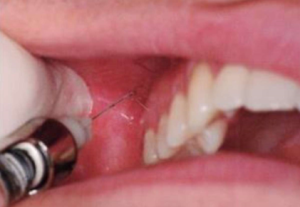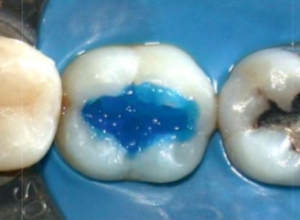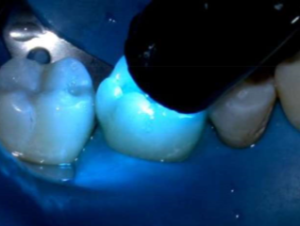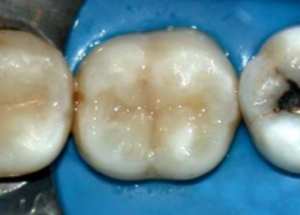
Composite resin fillings are a type of dental filling that has revolutionized dental restorations by providing a tooth-coloured alternative to traditional silver-coloured amalgam fillings. Most dental patients worldwide now prefer these naturally coloured teeth as opposed to any other. This article explores the development, composition, advantages, and disadvntages of composite resins, offering insights into why they have become the preferred choice for both patients and dental professionals.
What is a Composite Resin Filling?
A composite material is a solid made from two or more distinct materials that, when combined, produce better properties than the original two materials. For example, composites, like carbon fibre-reinforced polycarbonate, are used for their lightweight and rigidity in aerospace, civil engineering, the military, and motorsports.
In dentistry, composite resins are composed of three main parts:
- Organic Resin Matrix: Typically made of Bis-GMA, this viscous fluid forms the backbone of the composite and can bind to itself to create a strong solid.
- Fillers/Particles: These inorganic particles, such as silica or glass, are solids that are placed in composite resin to increase their mechanical properties and wear resistance.
- Silane Coupling Agents: These molecules bond the organic and inorganic components, enhancing the composite’s strength and durability.
The qualities that these materials give dental composites make them ideal for repairing cracked and decayed teeth. They are also used in other dental restorations like veneers and crowns. Composite fillings resist cavities and can withstand the moderate pressure from chewing, blending seamlessly with natural teeth.
Advantages of Composite Resins
Composite resins offer numerous benefits:
- Aesthetic Appeal: They match the natural tooth color, providing a visually pleasing restoration.
- Less Invasive: Compared to other types of dental fillings, the dentist doesn’t have to remove as much of your tooth to put in a composite filling.
- Easily Repairable: If composite fillings wear down or get damaged, they can be easily repaired, often at a lower cost than replacing the filling entirely.
- Mechanical Strength: Advances in technology surrounding composite resins have significantly improved the strength and durability of fillings.
- Reduced Tooth Sensitivity: By bonding with the tooth, composite fillings help insulate against temperature changes, although some initial sensitivity may occur.
- Biocompatibility: Composite resins are less toxic to dental pulp compared to older materials like PMMA.
- Improved Handling: Composites can be manipulated easily to adapt to various cavity shapes and sizes. This makes them useable in many situations outside of cavities such as chips and veneers.
- Long Lifespan: 10+ Years
Disadvantages of Composite Resins
Despite their advantages, composite resins are not without challenges.
- Staining: Just like natural teeth, composite resins can stain from things like coffee or tea. They may stain a different color from your natural teeth, especially at the place where the natural tooth and the composite resin meet.
- Cost: The initial cost for a composite filling can be more expensive than other fillings.
- More Technique Sensitive: Composite resins require more steps to accomplish compared to other filling materials. This makes them more prone to mistakes by dentists.
What to Expect During a Cavity Filling Procedure
The average time for one filling can range between 30-45 minutes, but additional teeth or cavities in between can take longer depending on size and clinician experience. The steps in the filling procedure generally follow this pattern:
During the Procedure
Local Anesthesia Administration:

During a filling procedure, a patient will first receive local anesthesia in the form of numbing gel, followed by an injection. This will make sure that they do not feel anything during the procedure.
Removal of Decay:

Following this, the decay will be removed with a high-speed handpiece which may make noise and involve water and air.
Acid Etching:

Next is a step known as etching. This is when a gel is applied to your tooth to create more surface area for the filling to connect to the tooth.
Priming:

Afterwards, a primer is applied to the tooth, which penetrates into dentinal tubules to create a surface for the filling material to connect to the tooth.
Bonding:

The bonding agent is then applied, and the filling material is placed into the cavity in layers before being light cured with an LED curing light to set it harden. This will be repeated as often as needed until your entire tooth is reconstructed.
Checking the Bite:

After most dental procedures, the bite should also be checked with a special type of paper to confirm the filling isn’t too big. If the filling is too big, this creates unneeded pressure, which increases the chance of the cavity breaking in the future.
Polishing and Final Checks:

Finally, any rough surfaces need to be polished with a smoothing instrument so they don’t irritate your tongue. During this step, the dentist will communicate with the patient to make sure that the filling is to their liking and that nothing needs to be changed.
Recovery and Aftercare
If the filling is taken care of properly, it can last many years. The average time a filling lasts depends on the material used – composites can last up to 10 years. After receiving a filling, make sure to:
- Brush and floss twice daily
- Schedule regular professional cleanings and exams
- Cut back on sugary snacks and drinks
- Use a fluoride mouthwash
- Wear a nightguard if you have bruxism (teeth grinding)
- Avoid hard, crunchy and sticky foods
- Quit smoking if you are a smoker
Conclusion
Composite resin fillings have come a long way since their inception, thanks to continuous advancements in materials science. They offer a durable, aesthetically pleasing, and biocompatible solution for dental restorations, making them a cornerstone of modern dentistry. As research progresses, we can expect even more improvements, further enhancing their performance and reliability.
Disclaimer
The contents of this website, such as text, graphics, images, and other material are for informational purposes only and are not intended to be substituted for professional medical advice, diagnosis, or treatment. Nothing on this website constitutes the practice of medicine, law or any other regulated profession.
No two mouths are the same, and each oral situation is unique. As such, it isn’t possible to give comprehensive advice or diagnose oral conditions based on articles alone. The best way to ensure you’re getting the best dental care possible is to visit a dentist in person for an examination and consultation.
SAVE TIME AND MONEY AT ANY DENTIST

Less dental work is healthier for you. Learn what you can do to minimize the cost of dental procedures and avoid the dentist altogether!

